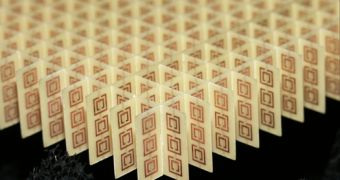The new metamaterial developed at Duke University and Boston College presents tiny geometric features that are able to absorb both the electric and the magnetic components of electromagnetic radiation, in specific frequencies of the microwave spectrum.
"Three things can happen to light when it hits a material. It can be reflected, as in a mirror. It can be transmitted, as with window glass. Or it can be absorbed and turned into heat. This metamaterial has been engineered to ensure that all light is neither reflected nor transmitted, but is turned completely into heat and absorbed. It shows we can design a metamaterial so that at a specific frequency it can absorb all of the photons that fall onto its surface," said Willie J. Padilla from Boston College.
By using the results of previous computer simulations and applying them in resonators that are capable of coupling electric and magnetic fields, the team successfully designed a material which can absorb all the incoming electromagnetic radiation. The material is constructed out of two elements which absorb separately the electric and magnetic components of electromagnetic radiation, meaning it can be used to develop other materials which have high electromagnetic absorption in specific narrow frequencies.
Opposite to other electromagnetic absorbers, this metamaterial is created out of metallic elements only, making it ideal for applications such as the collection and detection of light, said Padilla. The innovative design gives it better properties than those of the actual physical components used to build it, thus the response to radiation is highly tunable. Additionally, the material can be modified to operate over a much wider portion of the electromagnetic spectrum, since the elements used for its construction are geometrically scalable.
Also participating in the study along Padilla were Nathan I. Landy from Boston College and researchers David R. Smith, Soji Sajuyogbe and Jack J. Mock from Duke University.

 14 DAY TRIAL //
14 DAY TRIAL //